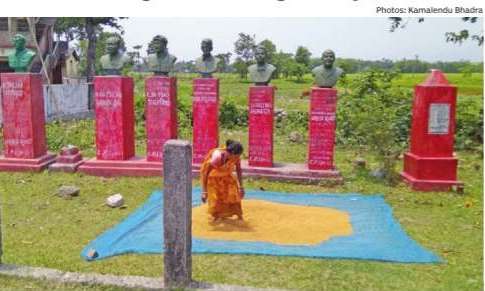Naxalbari
This is a collection of articles archived for the excellence of their content. |
2017: Changed political leanings
Avijit Ghosh finds out how demographics and politics have changed in the legendary ultra-Left's ground zero
The Mahalis are not home. Neighbours say the tribal couple and their children haven't been around for the past week.Among the poorest families in Dakhin Kotia Jote village, the Mahalis seem to have been caught in a political crossfire ever since they hosted BJP president Amit Shah for lunch last month.
Within a few days, they joined the Trinamool Congress, to much controversy . Now they are being protected, much like prized footballers by overzealous club officials in 1980s Calcutta. Two men in uniform stand guard 24x7, and within minutes of TOI reaching the spot, an assistant sub-inspector arrives on the scene. Interestingly, this game of one-upmanship is being played by two political parties who have no claim to Naxalbari's fiery history or indelible memory .
Shah's choice of Naxalbari as the launchpad of BJP's ambitious expansion plan is not random.Exactly 50 years ago in the summer of 1967, these picturesque parts of Darjeeling district became an open-air theatre for the struggle of peasants and tea garden workers against the oppression of jotedars (rich peasants).Even today, the name Naxalbari endures in the collective imagination as the motherlode of radical Red politics in India. An entire lexicon (Naxal, Naxalite, Naxalism) has been coined around it.
A lot has changed in Naxalbari since that heady summer of discontent. The statue that welcomes a visitor isn't of Charu Mazumdar, Kanu Sanyal or Jangal Santhal, the trio who led that movement, but of Suresh Chhetri, a Kargil braveheart martyred in the Dras sector in 1999.
The bazaar, the kasbah's bustling heart, reflects Naxalbari's new aspirations. Apart from shops selling mobiles and talk-time, there's a liquor store that stocks premium brands such as Teachers, Antiquity , Signature, and that favourite of '70s Bollywood villains, Vat 69. “We also sell Sula wine,“ says shop owner Joginder Prasad. The popular bakery outlet Mio Amore offers black forest pastries, chocolate dollops and chicken croissants. There's even a tattoo parlour, `A Touch of Ink, where you can get 3D or Japanese tattoos.
But nothing reveals the chang ing Naxalbari better than the spiraling land rates. NH-31, which runs parallel to the kasbah, is being widened. Rice mills and petrol pumps are being set up. “New well-heeled settlers from Manipur and other parts of North-East are buying land.Not long ago you could buy one bigha (1,333 sqm) of land for Rs 3 lakh. Now you get only one katha (67 sqm) for the same price,“ says Bhimraj Chhetri, who runs a small restaurant. One bigha is 20 kathas.The new Naxalbari, it seems, is in the midst of a torrid affair with materialism.And it isn't of the dialectical kind.
The area's demographics have changed and, consequently , its politics.Locals say that in the 1960s, the surrounding villages mainly had adivasis, Rajbonshis (a scheduled caste), and Nepalis who collectively formed the spine of the radical Left struggle. The relatively better-off Bangladeshis and Manipuris are the new settlers, with a smattering of Biharis.
“They didn't shift homes to partici pate in radical politics,“ says a shop keeper from Prasadojot village.
Electorally, the far-Left is a token presence in the SC-re served Matigara-Naxalbari as sembly seat. In 2016, they didn't even put up a candidate. To get a rough idea, in adjacent Phan sidewa, a reserved seat for STs, CPI (ML-Liberation) candidate Lalu Oraon got 1,596 or .88% of the votes. In Matigara-Naxalbari, Congressman Sankar Malakar (backed by CPM) retained the seat polling 41% votes. TMC got 32% while BJP's vote share leapfrogged to 21%, almost a 500% jump from its 2011 tally of 4.4%. Overall, BJP got 10.2% votes in Bengal. The saffron party holds one of 26 panchayat seats in Naxalbari. Dakhin Kotia Jote, where Shah came to lunch with the Mahalis. In other words, the saffron party has carved out a space in what was once the beating heart of the Radical Red movement.
The radical Reds, locals say, are having a hard time recruiting young members.Electronic goods salesman Pijush Das remembers the days when rallies with peasants and tea garden workers holding Charu Mazumdar banners used to be half a kilometre long. “Now there are hardly 20 people,“ he says. TMC's Prithwish Roy is dismissive about the ultra-Left presence in the region. “It is minimal. They have as many groups as cadres,“ he jokes.
However, the ultra-Left -CPI (ML) Red Star, PCC CPI (ML) and several other groups -has claimed the walls through graffiti and posters. In the coming days, every hue of the radical Reds will celebrate 50 years of the Naxalbari struggle with meetings in Siliguri and elsewhere hoping to draw inspiration.
Abhijit Majumdar, son of Charu Majumdar and Darjeeling district secretary of CPI (ML) Liberation, firmly believes that they are still relevant. He says, “There's a reason why Amit Shah came to Naxalbari. He knows it is a signpost of radical Leftism. The BJP can co-opt or wean away TMC in the future. But it knows that in the war against the ultraRight, only the radical Left will be the last men standing.“
